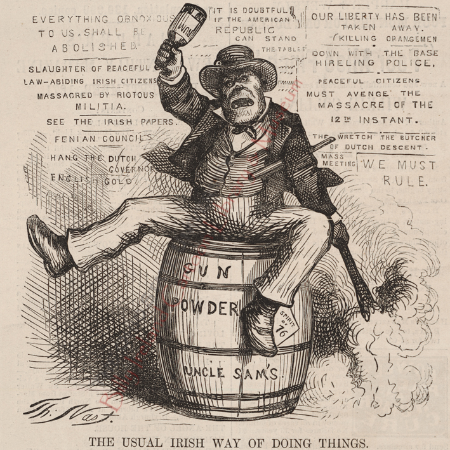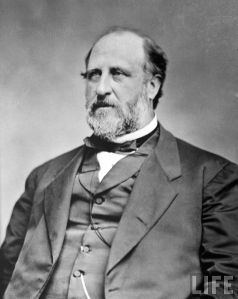Thomas Nast (1840-1902) was an amazingly talented and controversial artist during the latter half of the nineteenth century. Illustrator, painter, engraver, he is best known for his scathing caricatures and political cartoons that appeared in Harper’s Weekly’s Journal of Civilization, and which called out corruption and hypocrisy in American and especially New York City politics.They often referred to Nast as “Our Special Artist.”

Nast remains controversial today. His most recent nomination for induction into New Jersey’s Hall of Fame (Nast lived the majority of his time in Morristown) was doomed after a flurry of outrage and has been tabled for another year. With our politically correct fixations, he may never get in.
I first learned about Nast when I began exploring my family’s genealogy on sites like Ancestry.com. My lineage is 75 percent potato famine Irish, 25 percent Bavarian German. Raised in the Roman Catholic faith, if asked, my family identified ourselves as Irish-Catholic, but it was never a zealous, over-the-top kind of thing. I grew up thinking we were just “American” like everyone else. A sense of ancestral family history was never conveyed in our home. I was unaware of the experiences of my immigrant ancestors.
After seeing the 2002 film Gangs of New York, directed by Martin Scorsese, and watching an interview about the making of the film on Charlie Rose, I learned about a book titled Low Life: Lures and Snares of Old New York by Luc Sante (1992) and I decided to get a copy. It was a fascinating account of the American immigrant experience during the Gilded Age of New York City. It was through this reading that I first learned about Thomas Nast. I was surprised to discover that the Irish were looked upon as low life and wrote about it in an early blog.
For my first graduate course, American Art and Culture in Context, each student was assigned to select an artist to represent each century of American history and determine the cultural context in which it was created and why it was significant. I decided to narrow my focus to a particular genre, political/editorial cartoons, and selected Benjamin Franklin as an artist for the eighteenth, Thomas Nast for the nineteenth, and Patrick Oliphant for the twentieth century. Cartooning has always held a fascination for me. As a teenager, I was an amateur pen and ink artist. I fancied myself as a cartoonist and envisioned my career landing in newsprint. I had every intention of selecting art as my major in college and formally honing my skills and artistic voice – but when I found out that all the art classes began at 8 a.m. in the morning, I decided to switch my major to English. True story. Such is the wisdom of a 17-year old that puts sleeping in late at the top of her priorities!
Nevertheless, for me, an appreciation for art, and a particular enthusiasm for the oeuvre of Thomas Nast endures. It coincides well with my curiosity about nineteenth century American history, family heritage, politics in general, and how art influences culture and vice versa.

Thomas Nast is misunderstood. Given my heritage, I claim every right to put Nast on a $hit list, but I have chosen not to do so. I am not pleased to see my ancestors depicted as apes. I want to know where this comes from and why the stereotype, which originated in Great Britain, migrated to the United States and continued to thrive here for generations. I want to understand what made him draw images like this. Nast did not invent this stereotype, but he certainly perpetuated it. The image at right, The Usual Irish Way of Doing Things has made many appearances on the Web as an example of his vile Irish defamation. It is not a flattering portrait. The image is usually cropped to remove the story below, nor is it considered in the context of events that caused Nast to create the image. To fully understand the image, we need to understand the back story (which I will elaborate on in a future post).
One of the benefits of being trained as a journalist (aided by my position as a middle child) is to make oneself aware of all points of view, and present facts in context. It’s easy to stand on a soap box or slip behind a screen and keyboard and rant and rave about policies and positions – an advocate who is right and who is wrong. It would have been very easy to emotionally react to these images and be offended by what at first glance appears as cruel, salacious and mean spirited drawings spewed from Nast’s pen, brush, and pencil. Those were “my people” he maligned. Few would blame me for jumping on the “outrage” bandwagon.
I did not react with anger or outrage. Instead, I’ve chosen to ask “why?” Was Thomas Nast a racist? A hater? And if so, how does that happen to someone? Bigotry doesn’t occur in a vacuum. It is learned. How did his time, place and circumstance shape his views? Why does he appear to turn against the faith he was born into and raised for a time? Perhaps my minority Bavarian DNA has something to do with an internal need to find balance and explanation. I wanted to get as many sides of the Thomas Nast story as I could. As these pages and blog posts unfold, I will share the images in historical context, supported by academic research and established differences of opinion, including my own. Fair assessments based on facts. Those afternoon courses in good old fashioned journalism did not go to waste! You are welcome to draw your own conclusions, and by all means, share them.
Therefore, it is the purpose of this site to define who Thomas Nast was, what his politics were, his general philosophies and determine what exactly was his beef with the Irish and the Catholics? How did he treat other minority or immigrant groups? Scholars and students of Thomas Nast will generally agree he was a product of his time, he adopted and practiced a new form of Republicanism that was hard won by Abraham Lincoln, which advocated toleration for all races and creeds. When Nast called out the Irish or the Catholics, he did so to protest specific behaviors or practices that he felt were an abuse of power or ran hypocritical of American democratic ideals.

In Nast’s world, Irish and Catholics are inexorably intertwined with William Meager Tweed, the Tammany Hall Sachem or “Boss” that ran a corrupt “Ring” in New York City. Tweed was a Scots-Irish Presbyterian, and as a younger man was no admirer of Irish Catholics. All of that changed when Tweed quickly figured out the political value of this massive immigrant population. He cultivated the allegiance of the Irish and the Roman Catholic Church for expedient political reasons. In the view of many at the time, especially for the Republican, Protestant ruling elite, Tweed’s arrangement was a malodorous quid pro quo – votes for favors. That the Irish allowed themselves to be so manipulated by Tweed and how a particular church grew and benefited directly as a result of Tweed’s support with public funds is at the heart of Nast’s ink and ire.
Thomas Nast did not have a fundamental problem with the Irish or with Catholics. His family faith was Catholic! Nast was consistent in calling out corruption and hypocrisy wherever he saw it emerge. Had it not been for their political alliances, which in Nast’s view involved stolen elections and misappropriated public funds, there would be little reasons for Nast to attack the Irish Catholics. His pen would turn on anyone, or any group, who he felt had turned on his or her principles or moral code. I will examine Nast’s use of symbols and stereotypes and seek to explain, rather than excuse their employment in his work and commentary. Everything Nast drew, was executed with deep conviction. One may not agree with Nast’s conclusions, but those who are informed of his life and times find it difficult to question the well of integrity and consistency from with which Thomas Nast drew his creative inspiration.
